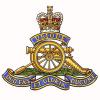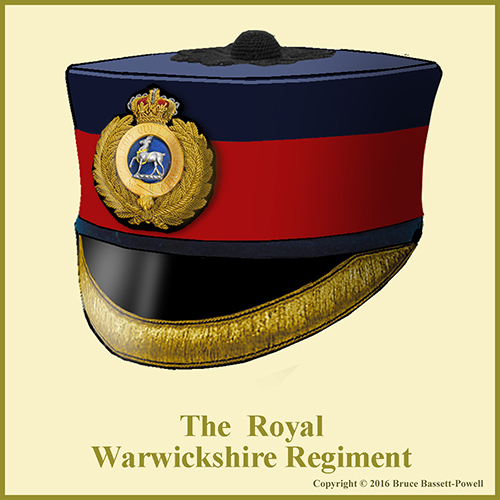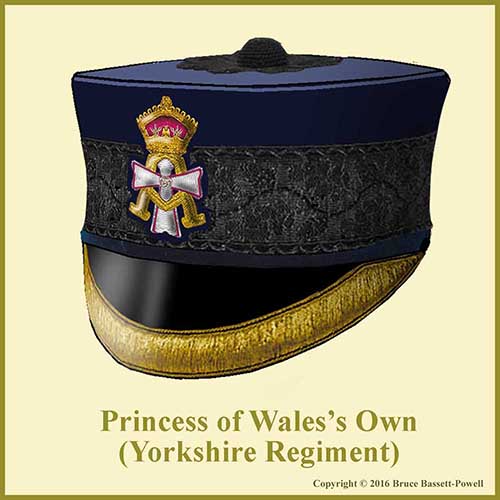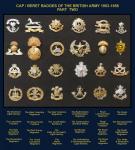-
Posts
44 -
Joined
-
Last visited
Content Type
Profiles
Forums
Blogs
Gallery
Events
Store
Everything posted by theironduke1
-
The mounted officer in the cocked hat in the first frame is not a Household Cavalry officer. He is the City Marshall of London whose job it is to challenge any armed group from without the city. (He also challenges the Queen when she visits the City). Because the Life Guards have the privilege of marching through the city with drums beating, bands playing, standards flying, swords drawn and bayonets fixed, he welcomed them to proceed after the challenge. This was the first time the Life Guards had exercised tis privilege since the Falklands War. It is so important a privilege that every member of the regiment turns out including veterinaries, surgeons and quartermasters.
-
An interesting new article on the Uniformology website on the round forage cap with peak, worn by officers, warrant officers and staff sergeants of the British infantry from 1880-1902. Deials of the elaborate badges, often made of gold and silver embroidery with velvet backings have largely been lost to history. However, using meticulous research, the editors of Uniformology have reproduced these caps and badges and are uploading them into the article. To access t hem, go to this link http://www.uniformology.com/FORAGE-CAPS-01.html . Here are two examples of the caps.
-

1847 pattern helmet
theironduke1 replied to blueman's topic in Great Britain: Militaria: Badges, Uniforms & Equipment
I think this is an 'other ranks' helmet from the North Somerset Yeomanry. It was worn by all ranks of the regiment from 1851-1900. Officers occasionally wore it after that time until 1914. The only difference between the officer's version and that of other ranks was in quality. The skull on the officer's was silver plated and the fittings were gilt and silver. For other ranks the skull was white metal and the fittings brass and white metal. In 1888 the regiment adopted a uniform almost identical to that of the 6th Dragoon Guards (Carabiniers). The difference being that the buttons were white metal for the N. Somerset Yeomanry and the yellow lace was replaced by white lace (silver for officers). -
Glenn. Thanks again and you are of course right. I have that badge and can replace it. What is that rank when worn by a band Warrant Officer? I have a lot of You Tube footage of Foot Guards Bands and I did notice while most of the badges were on a blue backing, I clearly saw a member of the Irish Guards Band with one on a red backing. Must be an anomaly. Regards Bruce
-

silver pouch
theironduke1 replied to blueman's topic in Great Britain: Militaria: Badges, Uniforms & Equipment
This is an Officer's pouch of the 7th (Princess Royal's) Dragoon Guards 1874-1902 -
Two things about the British Army wool shirt ..... I lived in Kenya in my early life (just after the Mau Mau emergency) ... when I was in the hills around Nanyuki and Nakuru in the evenings, I could sure have used one of those shirts ... it could be darn cold. When I returned to England I joined the Army. When I was shipped to Aden from Germany in the latter part of 1967 I was still wearing my standard issue woolen shirt and it was bloody uncomfortable most of the time. As we were only sent to secure the airfield there (about three or four weeks if I remember rightly) for the final evacuation we never got tropical issue. When we went to Cyprus the next year, we were properly kitted out, thank God!! That's the British Army for you!!
-
Here is a new book just published by Casemate Armies of Bismarck's Wars by Bruce Bassett-Powell It is available at Casemate and Caliver Books in the UK and Casemate, On Military Matters, Articles of War in the US. Also at Amazon, Barnes & Noble etc. If you want to see inside and get a signed copy, follow this link. www.uniformology.com
-

Wolseley Helmet
theironduke1 replied to paul kennedy's topic in Great Britain: Militaria: Badges, Uniforms & Equipment
Well it is definitely an original Wolseley pattern helmet with an RAMC (Royal Army Medical Corps) flash on the pugarree. However, the flash looks fairly new and current to me .. like a TRF or DZ Flash. Not sure what flash the RAMC would've worn in the pre WWII era. -

just bought helmets
theironduke1 replied to blueman's topic in Great Britain: Militaria: Badges, Uniforms & Equipment
The helmet on the left is 4th (Royal Irish) Dragoon Guards 1847 pattern Albert Helmet. The one on the right is The Life Guards, same pattern. -
It appears to be a 'lighter' duty belt than the normal load bearing kit. Having struggled in and out of '58 pattern webbing more times than I want to remember, I can't imagine this belt holding up to much wear & tear. I wonder if it is one worn by Military Police or some such. The nearest thing I saw to it in the two NATO uniform books I have is in the Netherlands army of the 1980s.
-

victorian side cap
theironduke1 replied to blueman's topic in Great Britain: Militaria: Badges, Uniforms & Equipment
This is a Royal Wiltshire Yeomanry side hat, probably SNCO version. 1899 or later. -

silver hussars plate
theironduke1 replied to blueman's topic in Great Britain: Militaria: Badges, Uniforms & Equipment
In the dress regulations of 1900 the device on the pouch for all lancers (except the 9th & 21st) was the royal cypher with crown above. The 21st Lancers had the Imperial Cypher with Imperial crown above. The device here is clearly the latter with the addition of crossed lances. It could be the 21st (bucking dress regulations as was the norm (and still is) in the British Army) or it could be an Indian Army lancer regiment. I will research further. -
Before 1993 the Military Cross was awarded to officers and the Military Medal to other ranks. They were merged that year to be the Military Cross only. The US equivalent is the Silver Star. The Distinguished Service Order (UK) is equivalent to the US Distinguished Service Medal (both Army & Navy variants). The Mentioned in Despatches (British spelling naturally) oak leaf was worn on the relevant campaign medal (in the case of our Major-General above - the first is on the France & Germany ribbon for 1944 and the second on the post WW2 General Service Medal ribbon. The MID is probably equivalent to the Bronze Star. I would suggest that a search for MID recipients post WW2 in any number of the post-colonial campaigns fought (Malaya, Palestine, Suez etc would yield results. I think Aden and certainly N. Ireland & the Falklands are a long time after retirement for this guy.
-
The Medals on his uniform are as follows:- Top Row - Order of the Bath / OBE. Middle Row - 1939-45 Star / Africa Star (With 8th Army att) / Italy Star / France & Germany Star Bottom Row - Defence Medal / War Medal 1939-45 (With Mentioned in Despatches Oak Leaf) / General Service Medal (With Mentioned in Despatches Oak Leaf) / Coronation Medal (QEII) Certainly a distingushed wartime career, but not an unusual one. Most of the medals in this array were probably sported by thousands, however the two Mentioned in Despatches could provide a clue. It looks like he would probably have retired in the mid to late nineteen-fifties given that his last medal was the Coronation one. Was probably made Order of the Bath on retitrement.
-

ww1 uniform ?
theironduke1 replied to blueman's topic in Great Britain: Militaria: Badges, Uniforms & Equipment
If Kevin can give a close-up of a button, we may be able to ascertain a unit. The cadet badge on the sleeve, is I believe a post 1945 badge and there were plenty of boys units (such as the Duke of York's Royal Military School in Dover) that wore the SD jacket and pants until the early 1960s. As to the MG gun Corps badge ... I cannot say .. The cap may be separate to the coat. Buttons may solve it. -

ww1 uniform ?
theironduke1 replied to blueman's topic in Great Britain: Militaria: Badges, Uniforms & Equipment
Well, it could be WWI or post WWI as the badge on the arm is a Cadet Force badge. Need a close up of the cap badge tomake a determination of unit. -

forage cap
theironduke1 replied to blueman's topic in Great Britain: Militaria: Badges, Uniforms & Equipment
That is a magnificent forage cap. The lace appears to be silver (Is that right?) and of the staff pattern. I would suggest that it could be the undress cap of a Lord Lieutenant of a Welsh county or something like that. It definitely dates from 1881 to 1902. The Welsh Regiment badge on the forage cap was similar, but the cap had a black embroidered band. Finally, the staff pattern lace angles to the left which was worn by Provost Marshalls so maybe he was a PM in Wales. -

sabretache id
theironduke1 replied to blueman's topic in Great Britain: Militaria: Badges, Uniforms & Equipment
I think this must be a costume piece, Kevin ... I don't think it is military and I've never seen it before. However, I can always be wrong!! -

RMP cap
theironduke1 replied to Markgraf's topic in Great Britain: Militaria: Badges, Uniforms & Equipment
It certainly is the cap of Royal Military police before 1953 and with the EIIR badge replacing the GVIR badge it continued in use until 1968. Normally, it would have been worn with a red cover as in the image of this one in my collection. -

ww1 tunic
theironduke1 replied to blueman's topic in Great Britain: Militaria: Badges, Uniforms & Equipment
You may very well be right Graham. I got the information from H. Taprell Dorling's book "Ribbons and Medals", 1974 No. 97 and I quote ..... "It was given to all officer's and men, doctors and nursing sisters who were actually serving in South Africa on or after 1 January 1902, provided thay had completed eighteen months war service on that date or afterwards completed it before June 1 1902. Bars inscribed 'SOUTH AFRICA 1901' and 'SOUTH AFRICA 1902' were given with it, and those who did not qualify for the King's medal were eligable to receive them with their Queen's medals. The green, white and orange ribbon of King Edward's South African Medal is never (My Italics) seen except in conjunction with the red, blue and orange ribbon of the Queen's, for if a man was awarded the former, he must also have been eligable for the latter." As with many forthright statements, Dorling may have overlooked the issue of the volunteer service companies. -
You are right that this could be a colonial volunteer unit and given the Belize connection, Timothy's assessment may well be correct. The bottom badge on his left arm is volunteer version of the 'Best shot in each Squadron, Company, Battery" etc. It was instituted in 1898. The upper badge is a prize badge first awarded in 1901 to Rifle Volunteers to encourage better marksmanship. It was reserved for all Sergeants and Lance Sergeants who were already marksmen and It was worked in silver lace. The crown above it certainly appears to be the Edward crown which would put the photo post 1902. Given the time it takes to get new orders and regulations to the colonies, I would date this photo to be 1903 to 1904.








